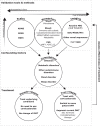Emerging Approaches for Validating and Managing Multiple Sclerosis Relapse
- PMID: 28424654
- PMCID: PMC5372802
- DOI: 10.3389/fneur.2017.00116
Emerging Approaches for Validating and Managing Multiple Sclerosis Relapse
Abstract
The autoimmune disease multiple sclerosis (MS) is characterized by relapses in the majority of patients. A definitive clinical diagnosis of relapse in MS can be complicated by the presence of an infection or comorbid disorder. In this mini-review, we describe efforts to develop enhanced imaging techniques and biomarker detection as future tools for relapse validation. There is emerging evidence of roles for meningeal inflammation, sex hormones, comorbid metabolic or mood disorders, and a dysregulated immune profile in the manifestation and severity of relapse. Specific subsets of immune cells likely drive the pathophysiology of relapse, and identification of a patient's unique immunological signature of relapse may help guide future diagnosis and treatment. Finally, these studies highlight the diversity in terms of relapse presentation, immunological signature, and response in patients with MS, indicating that going forward the best approach to assessment and treatment of relapse will be multifactorial and highly personalized.
Keywords: biomarker; comorbidity; cortical lesion; estrogen; pseudo-relapse.
Figures

Similar articles
-
Therapeutic management of severe relapses in multiple sclerosis.Curr Treat Options Neurol. 2015 Apr;17(4):345. doi: 10.1007/s11940-015-0345-6. Curr Treat Options Neurol. 2015. PMID: 25794777
-
Comorbidity increases the risk of relapse in multiple sclerosis: A prospective study.Neurology. 2017 Dec 12;89(24):2455-2461. doi: 10.1212/WNL.0000000000004716. Epub 2017 Nov 8. Neurology. 2017. PMID: 29117961 Free PMC article.
-
Mitoxantrone: a review of its use in multiple sclerosis.CNS Drugs. 2004;18(6):379-96. doi: 10.2165/00023210-200418060-00010. CNS Drugs. 2004. PMID: 15089110 Review.
-
Relapse prevalence, symptoms, and health care engagement: patient insights from the Multiple Sclerosis in America 2017 survey.Mult Scler Relat Disord. 2018 Nov;26:219-234. doi: 10.1016/j.msard.2018.09.002. Epub 2018 Sep 7. Mult Scler Relat Disord. 2018. PMID: 30368080
-
Hormonal and gender-related immune changes in multiple sclerosis.Acta Neurol Scand. 2015;132(199):62-70. doi: 10.1111/ane.12433. Acta Neurol Scand. 2015. PMID: 26046561 Review.
Cited by
-
Proteomic profile of extracellular vesicles from plasma and CSF of multiple sclerosis patients reveals disease activity-associated EAAT2.J Neuroinflammation. 2024 Sep 2;21(1):217. doi: 10.1186/s12974-024-03148-x. J Neuroinflammation. 2024. PMID: 39223661 Free PMC article.
-
Biomarker panel increases accuracy for identification of an MS relapse beyond sNfL.Mult Scler Relat Disord. 2022 Jul;63:103922. doi: 10.1016/j.msard.2022.103922. Epub 2022 May 28. Mult Scler Relat Disord. 2022. PMID: 35671674 Free PMC article.
-
Association of Mediterranean diet adherence with disease progression, quality of life and physical activity, sociodemographic and anthropometric parameters, and serum biomarkers in community-dwelling older adults with multiple sclerosis: a cross-sectional study.Aging Clin Exp Res. 2024 Mar 16;36(1):73. doi: 10.1007/s40520-024-02712-y. Aging Clin Exp Res. 2024. PMID: 38492093 Free PMC article.
-
Clinical-Radiological Mismatch in Multiple Sclerosis Patients during Acute Relapse: Discrepancy between Clinical Symptoms and Active, Topographically Fitting MRI Lesions.J Clin Med. 2023 Jan 17;12(3):739. doi: 10.3390/jcm12030739. J Clin Med. 2023. PMID: 36769392 Free PMC article.
-
Trajectories of disposable income among people of working ages diagnosed with multiple sclerosis: a nationwide register-based cohort study in Sweden 7 years before to 4 years after diagnosis with a population-based reference group.BMJ Open. 2018 May 9;8(5):e020392. doi: 10.1136/bmjopen-2017-020392. BMJ Open. 2018. PMID: 29743325 Free PMC article.
References
Publication types
Grants and funding
LinkOut - more resources
Full Text Sources
Other Literature Sources
Molecular Biology Databases

